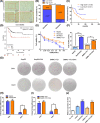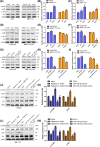Upregulated UCA1 contributes to oxaliplatin resistance of hepatocellular carcinoma through inhibition of miR-138-5p and activation of AKT/mTOR signaling pathway
- PMID: 33565716
- PMCID: PMC7874507
- DOI: 10.1002/prp2.720
Upregulated UCA1 contributes to oxaliplatin resistance of hepatocellular carcinoma through inhibition of miR-138-5p and activation of AKT/mTOR signaling pathway
Abstract
Hepatocellular carcinoma (HCC) inevitably developed oxaliplatin (OXA) resistance after long-term treatment, but the mechanism remains unclear. Here, we found that LncRNA UCA1 was upregulated in most of OXA-resistant HCC tissues and cells (HepG2/OXA and SMMC-7721/OXA). Follow-up analysis and online Kaplan-Meier Plotter revealed that HCC patients with high UCA1 level had a shorter survival compared with those with low expression. Overexpression of UCA1 increased OXA IC50 in HepG2 and SMMC-7721 cells, whereas knockdown of UCA1 decreased OXA IC50 in resistant counterparts. Moreover, dual luciferase reporter assay showed that co-transfection of UCA1-WT plasmid with miR-138-5p mimics enhanced fluorescence signals, whereas co-transfection of UCA1-Mut plasmid and miR-138-5p mimics did not induce any changes. Consistently, UCA1 levels in HepG2/OXA and SMMC-7721/OXA cells were downregulated after transfected with miR-138-5p mimics. UCA1 silencing or transfection of miR-138-5p mmics inhibited the activation of AKT and mTOR in HepG2/OXA and SMMC-7721/OXA cells, whereas UCA1 overexpression increased the phosphorylated AKT and mTOR levels in parental counterparts. Rapamycin or miR-138-5p mimics similarly suppressed the activation of AKT and mTOR, whereas UCA1 overexpression exert opposite roles. Interestingly, administration of rapamycin or miR-138-5p mimics apparently antagonized the effects of UCA1 on AKT and mTOR activation. Besides, depletion of UCA1 triggered more dramatic regression of HepG2 xenografts than that of HepG2/OXA xenografts with OXA treatment and impaired the p-AKT and p-mTOR levels in vivo. In conclusion, our findings provide the evidence that UCA1 may contribute to OXA resistance via miR-138-5p-mediated AK /mTOR activation, suggesting that UCA1 is a potential therapeutic target for HCC.
Keywords: UCA1; hepatocellular carcinoma; long noncoding RNA; miR-138-5p; oxaliplatin resistance.
© 2021 The Authors. Pharmacology Research & Perspectives published by John Wiley & Sons Ltd, British Pharmacological Society and American Society for Pharmacology and Experimental Therapeutics.
Conflict of interest statement
None.
Figures




Similar articles
-
Long noncoding RNA highly upregulated in liver cancer promotes the progression of hepatocellular carcinoma and attenuates the chemosensitivity of oxaliplatin by regulating miR-383-5p/vesicle-associated membrane protein-2 axis.Pharmacol Res Perspect. 2021 Aug;9(4):e00815. doi: 10.1002/prp2.815. Pharmacol Res Perspect. 2021. PMID: 34223709 Free PMC article.
-
Long noncoding RNA LEF1-AS1 acts as a microRNA-10a-5p regulator to enhance MSI1 expression and promote chemoresistance in hepatocellular carcinoma cells through activating AKT signaling pathway.J Cell Biochem. 2021 Jan;122(1):86-99. doi: 10.1002/jcb.29833. Epub 2020 Aug 12. J Cell Biochem. 2021. PMID: 32786108
-
Upregulated lncRNA-UCA1 contributes to progression of hepatocellular carcinoma through inhibition of miR-216b and activation of FGFR1/ERK signaling pathway.Oncotarget. 2015 Apr 10;6(10):7899-917. doi: 10.18632/oncotarget.3219. Oncotarget. 2015. PMID: 25760077 Free PMC article.
-
The Role of microRNAs in Regulating Cancer Cell Response to Oxaliplatin-Containing Regimens.Technol Cancer Res Treat. 2023 Jan-Dec;22:15330338231206003. doi: 10.1177/15330338231206003. Technol Cancer Res Treat. 2023. PMID: 37849311 Free PMC article. Review.
-
Ferroptosis-related oxaliplatin resistance in multiple cancers: Potential roles and therapeutic Implications.Heliyon. 2024 Sep 7;10(18):e37613. doi: 10.1016/j.heliyon.2024.e37613. eCollection 2024 Sep 30. Heliyon. 2024. PMID: 39309838 Free PMC article. Review.
Cited by
-
Current Molecular Biology and Therapeutic Strategy Status and Prospects for circRNAs in HBV-Associated Hepatocellular Carcinoma.Front Oncol. 2021 Jul 2;11:697747. doi: 10.3389/fonc.2021.697747. eCollection 2021. Front Oncol. 2021. PMID: 34277444 Free PMC article. Review.
-
Ventilagolin Suppresses Migration, Invasion and Epithelial-Mesenchymal Transition of Hepatocellular Carcinoma Cells by Downregulating Pim-1.Drug Des Devel Ther. 2021 Dec 1;15:4885-4899. doi: 10.2147/DDDT.S327270. eCollection 2021. Drug Des Devel Ther. 2021. PMID: 34880599 Free PMC article.
-
Advances in hepatocellular carcinoma drug resistance models.Front Med (Lausanne). 2024 Jul 31;11:1437226. doi: 10.3389/fmed.2024.1437226. eCollection 2024. Front Med (Lausanne). 2024. PMID: 39144662 Free PMC article. Review.
-
Upregulated lncRNA PRNT promotes progression and oxaliplatin resistance of colorectal cancer cells by regulating HIPK2 transcription.World J Gastrointest Oncol. 2024 Apr 15;16(4):1564-1577. doi: 10.4251/wjgo.v16.i4.1564. World J Gastrointest Oncol. 2024. PMID: 38660648 Free PMC article.
-
The Role of Long Non-Coding RNA and microRNA Networks in Hepatocellular Carcinoma and Its Tumor Microenvironment.Int J Mol Sci. 2021 Sep 30;22(19):10630. doi: 10.3390/ijms221910630. Int J Mol Sci. 2021. PMID: 34638971 Free PMC article. Review.
References
-
- Bray F, Ferlay J, Soerjomataram I, Siegel RL, Torre LA, Jemal A. Global cancer statistics 2018: GLOBOCAN estimates of incidence and mortality worldwide for 36 cancers in 185 countries. CA Cancer J Clin. 2018;68:394‐424. - PubMed
-
- Chang L, Hu Z, Zhou Z, Zhang H. Linc00518 contributes to multidrug resistance through regulating the MiR‐199a/MRP1 axis in breast cancer. Cell Physiol Biochem. 2018;48:16‐28. - PubMed
-
- Ferlay J, Soerjomataram I, Dikshit R, et al. Cancer incidence and mortality worldwide: sources, methods and major patterns in GLOBOCAN 2012. Int J Cancer. 2015;136:E359‐E386. - PubMed
-
- Campagnolo L, Telesca C, Massimiani M, et al. Different expression of VEGF and EGFL7 in human hepatocellular carcinoma. Dig Liver Dis. 2016;48:76‐80. - PubMed
Publication types
MeSH terms
Substances
LinkOut - more resources
Full Text Sources
Other Literature Sources
Medical
Miscellaneous

